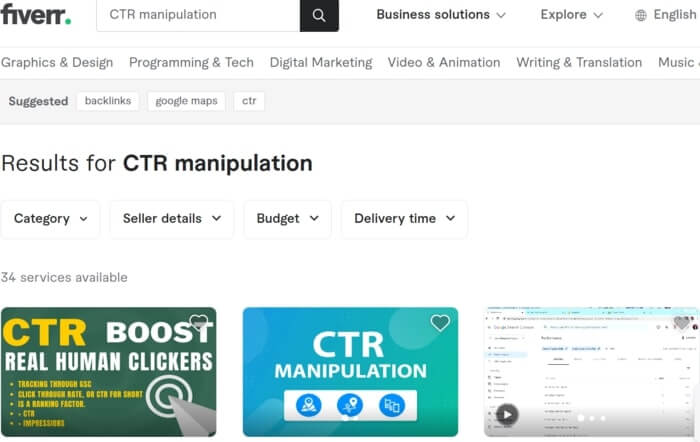How to Determine the Influence of CTR Adjustment on Your Advertising And Marketing
Understanding the nuances of click-through rate (CTR) adjustment in advertising is vital for companies striving for genuine customer interaction. By analyzing crucial metrics such as conversion prices and bounce prices, marketing experts can discover prospective disparities that may develop from synthetic improvements. Utilizing tools like Google Analytics and carrying out A/B screening can provide insights into the effectiveness of various approaches. Nonetheless, the effects expand past instant information; the lasting effects on brand name stability and user trust fund warrant cautious consideration. What remains to be discovered is exactly how these components interconnect and affect overall marketing success.
Recognizing CTR Manipulation
Recognizing CTR adjustment is essential for online marketers seeking to enhance their projects and ensure data integrity. Click-through rate (CTR) refers to the ratio of users who click on a particular link to the overall number of individuals that check out the promotion or web content.
The effects of CTR manipulation extend beyond simple information distortion; they can weaken count on digital marketing. When companies depend on inflated metrics, they might purchase ineffective projects, eventually hurting their return on investment. In addition, systems may penalize marketers taking part in such practices, leading to more implications for their advertising initiatives.
To successfully deal with CTR control, marketers have to establish an extensive understanding of their information sources and analytics devices. By utilizing advanced monitoring methods and looking at traffic sources, they can make certain and determine irregular patterns that their efficiency metrics reflect authentic customer interaction - CTR Manipulation Service. This alertness is vital for fostering long-lasting success in an increasingly affordable digital landscape
Secret Metrics to Analyze
Efficient evaluation of key metrics is essential for assessing truth performance of advertising projects and detecting prospective CTR adjustment. One main statistics to consider is the Click-Through Rate (CTR) itself, which stands for the proportion of users that click an ad to the complete number of individuals that see it. An abrupt spike in CTR may suggest adjustment, necessitating further examination.
In addition, keeping track of conversion prices is crucial. A high CTR with a reduced conversion price could indicate that the clicks are not authentic or that the targeting is misaligned (GMB CTR Manipulation). Assessing bounce rates can offer insight into individual interaction; a high bounce rate after a click may suggest that the web traffic is not quality-driven.

Devices for Dimension

In addition, A/B screening devices such as Optimizely or VWO can assist in trial and error with various ad variations to determine which elements drive higher CTR. These devices permit online marketers to analyze real-time performance and make data-driven modifications. Social network analytics devices, like Hootsuite or Sprout Social, can additionally contribute in comprehending CTR within social systems, providing insights into audience habits and involvement fads.
Moreover, heat mapping tools, such as Hotjar, can disclose just how users interact with ads, helping to determine where enhancements can be made. Incorporating these tools develops a durable dimension structure, making it possible for marketers to discern the effects of CTR manipulation efficiently. Eventually, the best choice of measurement devices is essential for making notified advertising and marketing choices and maximizing campaign efficiency.

Reviewing Long-term Effects
One have to think about the lasting effects of CTR manipulation on general advertising and marketing efficiency, as temporary gains can often mask deeper ramifications. With time, artificially inflated click-through rates may result in decreased depend on from customers and internet search engine alike. When customers repetitively encounter deceptive practices, they may become hesitant to involve with the brand, causing lower conversion rates in the future.
Furthermore, algorithm updates from platforms such as Google are designed to prioritize genuine involvement over filled with air metrics. Businesses that rely on CTR adjustment might discover themselves penalized, leading to a decline in natural reach and exposure. This can have a cascading effect on brand name credibility Click Here and consumer commitment, ultimately undermining the really objectives that the preliminary control sought to attain.
In addition, the data accumulated from controlled CTR may misdirect marketing professionals in their method development. Relying upon skewed information can lead to misguided projects that fail to reverberate with the target audience, leading to thrown away resources and missed out on chances. Therefore, it is critical for marketing professionals to evaluate the lasting implications of CTR manipulation and focus on sustainable, moral engagement approaches for lasting success.
Honest Factors To Consider in CTR Adjustment
In the realm of digital advertising, ethical factors to consider bordering CTR adjustment are critical. While the need to boost click-through prices (CTR) can lead to short-term gains, the possible long-lasting repercussions on brand name stability and consumer depend on can not be forgotten. Adjusting CTR typically involves methods that may misinform individuals, such as clickbait headlines or misleading advertising and marketing methods. These strategies can lead to a transient boost in traffic yet may eventually deteriorate customer confidence.
Furthermore, honest concerns encompass conformity with regulations such as the Federal Trade Payment (FTC) guidelines, which mandate transparency in advertising. Falling short to follow these standards can subject companies to legal ramifications and harm their online reputation. Marketing experts have to think about the ramifications of their approaches on user experience and the broader sector landscape.
Additionally, the surge of man-made knowledge and automation in marketing offers further moral issues. The capacity for algorithmic bias or the exploitation of consumer information raises questions about responsibility and fairness. Eventually, ethical advertising practices must prioritize transparency, honesty, and regard for the consumer, cultivating lasting Recommended Reading partnerships that transcend plain metrics like CTR. Stabilizing performance with values is vital for sustainable success in the digital industry.
Verdict
Finally, gauging the effect of CTR manipulation on advertising and marketing requires a comprehensive analysis of vital metrics, consisting of click-through rates, conversion prices, and bounce rates. Using analytics devices look what i found and conducting A/B screening can provide important understandings right into customer engagement and web traffic quality. Additionally, assessing long-lasting effects and sticking to moral considerations is necessary for notified decision-making. Inevitably, a data-driven approach makes sure that advertising and marketing strategies are reliable and aligned with authentic individual communications.
Understanding the nuances of click-through rate (CTR) control in advertising and marketing is essential for businesses striving for genuine user interaction.Efficient evaluation of key metrics is critical for reviewing the true performance of advertising and marketing projects and finding possible CTR adjustment.One must consider the long-term results of CTR manipulation on total advertising performance, as short-term gains can frequently mask much deeper effects.In the world of digital marketing, moral considerations bordering CTR adjustment are paramount.In conclusion, gauging the impact of CTR control on advertising requires an extensive evaluation of crucial metrics, including click-through prices, conversion rates, and bounce rates.
Comments on “The Influence of a CTR Manipulation Press Release on Brand Awareness”